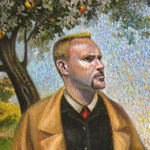
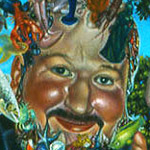
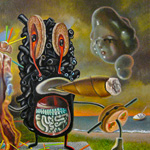
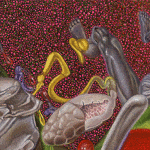
No Home Anywhere Else: The first two images are commissioned paintings. Early versions of Animus of Treacle make up the third composite image. The last image is from the original version of Archimboldo Ant Farm. I later de-cluttered the upper portion of this picture in favor of a simpler background. The finished work made be seen on the first Gallery page.
Copying Willem de Kooning: I have copied few works of art in my life, and none post-maturation. However, I thought that, should I do it again, I would copy someone I both admire and whose work is very different from my own. As a gift to my sister, I made a small version of Willem de Kooning’s Untitled II.
What I like about de Kooning’s abstract-expressive oil paintings is how he excavates, almost at the very end of his process, with semi-transparent white. The effect creates misty veils of negative space that weave through his elements. This technique is common among realist landscape painters who used diffuse light filtering through tree branches to soften up the space. Often this done late in a painting.
Here is a comic I made some years ago on the subject of Willem de Kooning.
Color Pencil Sketchbook n1: One Christmas I received a small 4.5" by 7" sketch pad that included color pencils. I draw in it during particularly slow teach days. The pencils are admittedly inferior but workable given restraints and time restriction. The first sketch was committed to paper around March 2015. Here are the best of the book.
Color Pencil Sketchbook n2: A second sketchbook was started in July 2021. This pad is smaller than the first.
Sketches and Preliminary Work: Ink and pen drawings, manipulated drawings, and tablet drawings from various projects.
The Heads: This is a selection of heads from early Profiles in Confusion storyboards. Each board contained twelve heads. Later I switched to tablets where the drawings were less organized. Complete comics can be read in my Comics Portal.
Pre-Book Art 1975-1977: I still possess a small number of early comics dating from grade school around 1966. These are discussed on the last page of my Comics Portfolio, which can be accessed through my Comics Portal. Other types of drawings at this time included fictitious rock stars, monsters, and doodles. These last examples were made in my late teens when I drew very little.
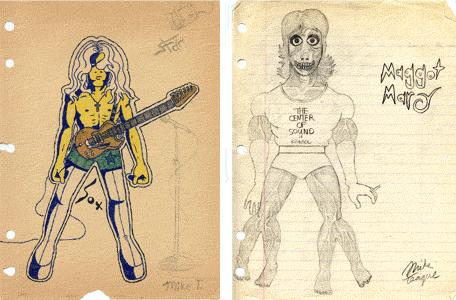
Art Books 1978-1982: The early timeline for these efforts is unclear. I submitted examples from my early art books to The Memphis Academy of Art for scholarship consideration. (I may have submitted the actual handbound books.) I received an honorable mention, but no scholarship.
Imagination vs Skill: I have never been a prodigy in the conventional sense. My first talent, from childhood, was imagination. I had an imaginary friend as a boy. I also performed puppet shows for my cousins using rubber monster toys as characters. When I took up drawing, it was to give expression to my imagination. However, imagination lacks purchase unless it can be set on a polished pedestal where it may be showcased to best effect. It was the polished pedestal part of this equation that eluded me at this age.
My first art book, The Clay Pigeon Sonnets, was completed by 1980. It contained drawings colored with oil paint, similar to the Vivien Leigh posters seen on my fifth Blog page (numbered New Blog 3). In 1978, I was a music major at a junior college, and then, around 1980, I became a music composition major at The University of Memphis. I made oil illustrations for my musical compositions, so it was natural to combine music and art in future books.
I acquired rapidograph pens during my brief detour through the graphic arts program at The University of Memphis around 1981, which followed my detour through being a music composition major. Where piano performance was an obstacle for me as a music major, hand-lettered type was an obstacle for me as a graphic arts major. (This was before computer graphics!) I thought more like an illustrator than a graphic designer, so never did better than a B in these classes. I switched to fine art around 1982.
My final three art books included rapidograph pen artwork, such as seen in the above for-credit graphic art project. However, acrylic replaced oil as my preferred painting medium for paper. I acquired acrylic paints for foundation classes at The University of Memphis prior to starting studio classes, and made use of them for personal projects. This Dali-inspired portrait of Katherine Hepburn dates from 1981-82.
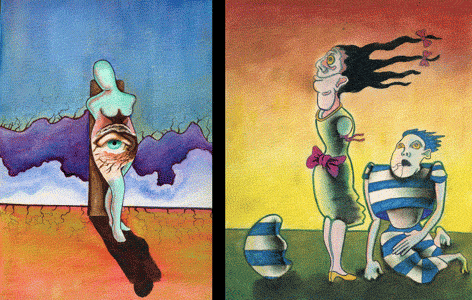
I made four art books in total: The Clay Pigeon Sonnets, The Ballerina’s Wet Dream, Aesthetics and Astronomy, and My Romantic Existence. The two middle books included some oil drawings. Here are the acrylic and oil drawings side by side. I call these drawings since I was not yet thinking three-dimensionally as an artist in these examples. The use of outlines are a graphic element.
Sigourney Weaver, painted with acrylic on paper, is significantly larger than works made for my last art book. Its creation coincided with foundation classes at U of M, but it was otherwise a personal project. In lacking inked outlines, Sigourney Weaver was a painting and not a drawing. By this stage I had already started painting in oil on canvas, so this was a natural progression in technique.
I saw Sigourney Weaver in Alien around 1980, and started a memoir around 1981. My memoir gave expression to all the gushing romantic sentiment that did not fit into art books. My love of putting things in books continues to today, except now the archiving process is electronic, and the “book” is my website.
A Life in Review: I am more willing to dwell on research materials of recent history than anything of ancient history, especially given I have been a poor archivist of my work process. Until recently I thought these assorted whatnots immaterial to the final product, but as I age, and the amount of work I make decreases, I see myself reaching into these files like reserve batteries.
When I make preliminary sketches, I do so reluctantly. In times past, omitting this process proved costly. I sometimes ended up with something that was not well thought out. Simultaneously, the same cautious process may leave you with a static, unadventurous product, where the “flight of fancy” aspect of the venture has been pruned away with gardening shears.
I never fail to be curious about other creators’ thought processes. (Elgar’s unfinished Third Symphony is a passion of mine, as are Schubert’s unfinished piano sonatas.) It is rare when a preliminary sketch fails to find its mark: The salient idea is usually there. Seeing these doodles all together reminds me how much thinking and effort is found in stalling maneuvers.
I had a large tub of early childhood drawings. In filling this container initially, I had to make hard choices about what to keep and what to throw away. I was tired, and chucked half of what was set aside, hoping that I retrieved those scraps of paper that meant something to me emotionally, since little of what I found had artistic merit. I later threw out most of the remainder when I was not tired. Should history find me, I hope this admission will not shock historians.
I have kept my art books as described above, and most everything I set down on quality paper after 1980 dating from my art school years. This list does not include many paintings and sculptures from the same period, but I discuss why these works were destroyed in my Portfolio pages.
Copyright © 2021 michael l. teague all rights reserved.